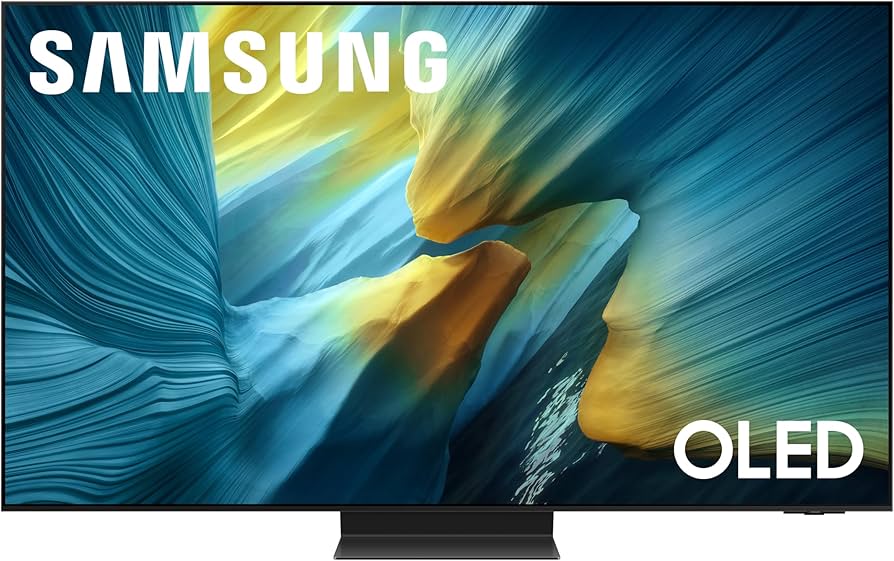In the United States, smart TVs have gone from luxury to staple. According to a 2025 report, the U.S. smart TV market is projected to grow from $54.95 billion in 2024 to $134.97 billion by 2033, fueled by a compound annual growth rate (CAGR) of 10.50% from 2025 to 2033. That level of expansion speaks volumes about the evolving role TVs play in entertainment and technology ecosystems, and Samsung is leading that charge.
Over the years, Samsung has held its ground and pushed the entire sector forward. Known for combining sleek design with cutting-edge functionality, the brand has become synonymous with premium displays and forward-thinking features within the television manufacturing industry. Now, with the release of its 2025 flagship, the S95F OLED TV, Samsung once again raises the bar for what a television can—and arguably should—be.
A Dominant Force: Samsung’s OLED TV Lineup
Samsung’s OLED journey didn’t start with a bang, but its rise has been deliberate and impactful. While competitors like LG jumped in early, Samsung took its time refining the tech. Today, its OLED lineup is not only competitive, but it’s also setting standards.
The most recent proof of this is the Samsung 83″ Class OLED S90C. With Tizen OS and built-in Amazon Alexa, this Samsung TV is one of the most highly rated featured on QVC. Designed to deliver smart functionality without overcomplicating the user experience, the model’s Tizen has a streamlined interface that makes it easy to switch between streaming apps, live TV, and smart home controls—all while running efficiently in the background.
Display-wise, Samsung has elevated its OLEDs with features like Quantum HDR OLED+, improving contrast and color reproduction. Blacks are deeper, highlights are more vibrant, and there’s less image retention compared to older OLED generations. This makes a noticeable difference whether you’re watching action-packed movies or high-motion sports.

The 2025 Flagship: Inside the Samsung S95F OLED TV
The Samsung S95F OLED TV isn’t just another annual refresh. Rather, it’s the clearest signal yet that Samsung is doubling down on OLED innovation in 2025. After years of refining its OLED strategy, the S95F stands out as the brand’s most feature-rich and forward-thinking television to date.
At the heart of the S95F is the NQ4 AI Gen2 Processor, a second-generation chip that leverages deep learning to do more than just upscale your 1080p content. This processor actively analyzes each scene, frame by frame, adjusting brightness, color, contrast, and sharpness in real time. The result? Sharper edges, more realistic skin tones, and HDR performance that pops without blowing out highlights. What really sets this model apart is its OLED Glare-Free technology, which provides a matte finish. Traditional OLED panels tend to suffer in brightly lit environments due to their glossy surfaces. The S95F solves that with a new screen coating that diffuses light without compromising color fidelity. Whether you’re watching a dark thriller at noon or a live football game in the evening, surface reflections won’t ruin the experience.
Samsung also doubled down on motion performance. With a 165Hz native refresh rate, the S95F is tailored for all types of content consumers who need buttery-smooth visuals. Combine that with HDMI 2.1, Variable Refresh Rate (VRR), and Auto Low Latency Mode (ALLM), and you’ve got a TV that’s fully optimized for the latest consoles like the PS5 and Xbox Series X. Frame tearing and lag? Not here. QD-OLED also improves picture quality, pushing brightness levels higher than most OLEDs on the market without compromising the deep black levels that make these panels so beloved. Highlights are crisp, and the dynamic range feels more cinematic than ever.
Sound gets a similar upgrade thanks to Object Tracking Sound+. This system uses speakers around the edge of the TV to follow the movement on-screen, giving the illusion that sound is coming directly from the action. It makes a surprising difference—explosions feel like they’re happening around you, not just through the front-facing speakers. Smart features are handled through Tizen OS, Samsung’s proprietary platform that’s now more responsive and intuitive than ever. The UI has been polished, voice controls (via Alexa and Bixby) are snappy, and streaming app support is as deep as any platform out there. Samsung’s Gaming Hub, first introduced in earlier models, returns with enhancements, letting players access cloud gaming services like Xbox Cloud Gaming and NVIDIA GeForce Now without needing a console.
And while design can sometimes be an afterthought in performance-focused TVs, the S95F nails the aesthetics. It’s incredibly thin, with nearly invisible bezels and a minimalist rear panel that makes wall-mounting seamless. The ultra-slim One Connect Box keeps cables hidden and organized, contributing to a clean, modern look. In short, the S95F feels like a convergence point, where Samsung’s years of OLED research, AI development, and user feedback all meet. It’s not just a good TV. It’s a flagship in every sense, designed to satisfy tech enthusiasts, gamers, film buffs, and design-conscious consumers alike.
Hits From the Past: Samsung’s Iconic TV Innovations
That said, Samsung’s impact on television is not limited to OLED options. One of the most talked-about examples of the company’s drive to create well-rounded viewing experiences is its Frame TV. Known for going viral upon release a few years ago, this combines QLED picture quality with a picture-frame aesthetic. In Art Mode, it displays curated or personal artwork when idle, transforming the TV into part of the room’s decor. The customizable bezels and no-gap wall mount helped it appeal to many, especially among users who value form and function.
Beyond the Frame, Samsung has also delivered with its Neo QLED lineup, using Mini LED technology for improved local dimming and brightness control. Models like The Serif and The Sero have also shown that Samsung isn’t afraid to experiment with form factors, creating TVs that stand out in any space.
The Future of Samsung TV: More Than Just Screens
So, what does Samsung’s roadmap look like going forward? If recent moves are any indication, it plans to go beyond screen resolution or size by merging TV tech with the broader entertainment ecosystem.
Take their recent collaboration with NBCUniversal and Fortnite, for example. As reported by Geek Vibes Nation, Samsung launched Tonight at the Rock, an interactive experience inside the Fortnite platform. Here, it blends media, gaming, and social spaces into one virtual experience powered by Samsung’s tech.
This kind of cross-platform engagement could redefine what television means in the future. We’re moving toward a world where your TV evolves into a portal to new forms of content, community, and digital immersion. As flexible screen technology matures, expect to see more AI-driven features, collaborations with gaming platforms, and potentially even foldable or rollable displays. Samsung already leads in smartphone display innovation; applying that same mindset to TVs could shake up the entire industry.
From standout models like the S90C and Frame TV to the groundbreaking S95F OLED, Samsung continues to innovate how people experience entertainment. With control of nearly 50% of the global TV market, Samsung’s message is clear: whether it’s through dazzling visuals, smart software, or immersive collaborations, the future of television is already here—and they’re leading the charge.

DC Fanboy! Superman is the greatest comic book character of all time. Favorite movies are Man of Steel, Goonies, Back To the Future





![‘Frankenstein’ Review – Guillermo del Toro’s Definitive Look At The Nature And Nurture Of Monstrosity [TIFF 2025] ‘Frankenstein’ Review – Guillermo del Toro’s Definitive Look At The Nature And Nurture Of Monstrosity [TIFF 2025]](https://cdn.geekvibesnation.com/wp-media-folder-geek-vibes-nation/wp-content/uploads/2025/10/Frankenstein-175_PF_20240430_20377_R-300x200.jpg)
![‘Wake Up Dead Man: A Knives Out Mystery’ Review – In Rian Johnson We Trust [LFF 2025] ‘Wake Up Dead Man: A Knives Out Mystery’ Review – In Rian Johnson We Trust [LFF 2025]](https://cdn.geekvibesnation.com/wp-media-folder-geek-vibes-nation/wp-content/uploads/2025/10/Wake-Up-Dead-Man-A-Knives-Out-Mystery-300x169.jpg)